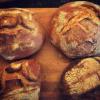March 2, 2017 - 7:59am

Convection oven for tartine-style
I am starting a micro-bakery, baking 400g tartine-esque boules in a convection oven, so using a Dutch oven is out of the question. Baking stones are also not feasible right now for various reasons but perhaps you can convince me. Tenting with foil and adding water to the bottom of the oven is working pretty well for steam but I'm still finding that to get them JUST cooked in the middle, the outside (including the bottom)is getting over done. I have lowered the temp to 450 (oven is accurate) and still have this problem. Solutions?


Why not use dutch oven?
As I said, I'm starting a bakery, so Dutch ovens are not practical.
Those are quite small loaves. Mine usually scale (wet dough weight) at 750 grams, and I bake mine in smaller cast iron pots (I think they are 3 quart / 2.7 liters). I can fit eight of these in my big wall oven and three in my little oven downstairs. Just how small is this convection oven of yours? How many loaves were you thinking of baking at once? If it's very small you will probably need some way to protect the dough from being too close to either of the elements (assuming there is one on the top and one on the bottom). A stone would certainly help with the issue of the bottom burning. Even two baking sheets stacked one inside the other under the loaf would help.
400g is the standard UK weight for a small loaf. It has to be 400g baked weight - actually a little more as you have to cater for loss due to evaporation for as many days as you give it shelf-life. I typically scale my small loaves at 515g which is a little generous, but it makes for a nice sized loaf.
-Gordon
Oh, that's interesting. I do have a couple of loaves that I scale smaller, mostly because of the ingredients (so, the cheese bread is smaller because it's a specialty-kind of bread with more expensive ingredients; there's another bread I make that has a lot of soaked grains etc). That way I keep the price the same, making it easier for my regular customers to put money down on account and get the same number of loaves for that, regardless of type of loaf.
I never actually weigh my loaves once they're baked. I suppose I should. :)
in theory I should and there is a certain amount that are allowed to be under by a certain (small) margin - in batches of 40 and 80 loaves... When I mentioned to the local Trading Standards people (formerly known as Weights & Measures) that I often don't make 40 a day, they became somewhat disinterested, but did insist I buy expensive "legal for trade" scales.
Here in the UK you can mark a loaf as "small" with the knowledge that it's at least 400g - same for large which is 800g (I scale my largers at 910g of dough - again a little generous, but it's fine and makes the dough calculations easier!) Everything else is supposed to have a label with the weight marked on it, but go to markets, etc. and you'll see unbagged bread where you can only guess the weight... Oh well.
-Gordon
Yes, we 'tiny traders' are often under the radar, but that's probably a good thing. There's a broad line between too much regulation, and keeping people safe.
Anyway, my original comment had less to do with questioning the size of the loaves for sale, and more to do with Dutch ovens being impractical for micro bakers. I can actually fit more loaves into my oven in the small cast iron pots (eight of them at once) than free-form loaves on the two granite slabs (six loaves), so I find it quite practical for my little bakery business. Of course, it depends on the size of your oven too.
weight for me, Since my bread tends to be high hydration and I bake it bold, it is not unusual to lose 15% of its original weight when done. Other, usually white, breads that aren't so wet to begin with, lose less - about 12%.
The loaves from Tartine Bakery are huge and have a delectable moist crumb. A 400 gram loaf has more surface area per gram so it will lose more moisture during baking if you bake at the same temperature for the same time.
I suggest experimenting with reduced oven temperatures to let internal temperature equilibrate. Maintain ample steam in the oven.
The bread should look like this when it removed from the oven: http://assets.marthastewart.com/styles/wmax-1500/d31/mld106708_0111_tartinebread_331/mld106708_0111_tartinebread_331_sq.jpg
Boules have less surface area per gram than batards. Spritzing with water before baking may reduce premature caramelization of the crust.
is more efficient because you are moving hot air across the surface of the product, same as windchill is more efficient at cooling. You have to lower the temperature until you get the expected results. When we bought our first convection oven we made a lot of muffins every morning, at first we always had these volcanoes of batter come out a mis-shaped muffin peak, once we found the right temperature the muffin tops spread as expected and no more batter would be pushed through the surface.
Gerhard